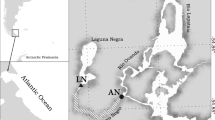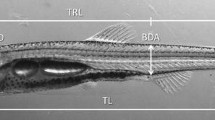Abstract
Phenotypic plasticity in response to environmental variability is one of the main characteristics of cephalopods. This study compares growth and life span of Octopus tehuelchus in different coastal environments of San Matías Gulf (Patagonia) at three different periods. The progression of maturity jointly with modal progression analysis and the detection of hatchlings in the natural environment were used to differentiate cohorts and assign ages. Growth was described using the oscillatory von Bertalanffy growth model. Within San Antonio Bay, O. tehuelchus seems to have the most favourable conditions for an extended spawning season and the development of two sub-annual cohorts. O. tehuelchus growth is strongly seasonal with slow growth rates during winter. There were differences in the growth pattern between sites and particularly between sub-annual cohorts in San Antonio Bay. The growth pattern in each site seems to be similar along the last 26 years. The results of our study make evident the variability and plasticity of O. tehuelchus in response to the environment.







Similar content being viewed by others
References
Aliotta S, Schnack EJ, Isla FI, Lizasoain GO (2000) Desarrollo secuencial de formas de fondo en un régimen macromareal. Asoc Arg Sed 7(1–2):95–107
Arreguín-Sánchez F, Solis-Ramírez MJ, González de la Rosa ME (2000) Population dynamics and stock assessment for Octopus maya (Cephalopoda: Octopodidae) fishery in the Campeche Bank, Gulf of Mexico. Rev Biol Trop 48(2–3):323–331
Aubone A, Wöhler OC (2000) Aplicación del método de máxima verosimilitud a la estimación de parámetros y comparación de curvas de crecimiento de von Bertalanffy. INIDEP Informe Técnico 37. ISSN 0327-9642
Batthacharya CG (1967) A simple method of resolution of a distribution into Gaussian components. Biometrics 23:115–135
Begon M, Townsend CR, Harper JL (2006) Ecology: from individuals to ecosystems. Blackwell, UK
Boyle PR, Boletzky SV (1996) Cephalopod populations: definition and dynamics. Phil Trans Biol Sci 351(1343):985–1002
Boyle P, Rodhouse P (2005) Cephalopods: ecology and fisheries. Blackwell, Singapore
Caveriviere A, Domain F, Diallo A (1999) Observation on the influence of temperature on the length of embryonic development in Octopus vulgaris (Senegal). Aquat Living Resour 12:151–154
Chapela A, González AF, Dawe EG, Rocha FJ, Guerra A (2006) Growth of common octopus (Octopus vulgaris) in cages suspended from rafts. Sci Mar 70:121–129
Collins MA, Boyle PR, Pierce GJ, Key LN, Hughes SE, Murphy J (1999) Resolution of multiple cohorts in the Loligo forbesi population from the west of Scotland. ICES J Mar Sci 56:500–509
Cortez T, Castro BG, Guerra A (1995) Feeding dynamics of Octopus mimus (Mollusca: Cephalopoda) in northern Chile waters. Mar Biol 123:497–503
Cortez T, González AF, Guerra A (1999) Growth of Octopus mimus (Cephalopoda, Octopodidae) in wild populations. Fish Res 42:31–39
Domain F, Jouffre D, Caveriviere A (2000) Growth of Octopus vulgaris from tagging in Senegalese waters. J Mar Biol Assoc UK 80:699–705
Doubleday Z, Semmens JM, Pecl G, Jackson G (2006) Assessing the validity of styles as ageing tools in Octopus pallidus. J Exp Mar Biol Ecol 338:35–42
Dunn MR (1999) Aspects of the stock dynamics and exploitation of cuttlefish, Sepia officinalis (Linnaeus, 1758), in the English Channel. Fish Res 40:277–293
Forsythe JW (1993) A working hypothesis on how seasonal temperature change may impact the field growth of young cephalopods. In Okutani T, O’Dor RK, Kubodera T (eds) Recent advances in cephalopod fisheries biology, Tokio, pp 133–143
Forsythe JW (2004) Accounting for the effect of temperature on squid growth in nature: from hypothesis to practice. Mar Freshw Res 55:331–339
Forsythe JW, Hanlon RT (1988) Effect of temperature on laboratory growth, reproduction and life span of Octopus bimaculoides. Mar Biol 98:369–379
Forsythe JW, Walsh LS, Turk PE, Lee PG (2001) Impact of temperature on juvenile growth and age at first egg-laying of the Pacific reef squid Sepioteuthis lessoniana reared in captivity. Mar Biol 138:103–112
Gayanilo FC, Sparre P, Pauly D (2005) FAO-ICLARM Stock assessment tools II (FiSAT II). User’s guide. FAO Comp Inf Ser (Fisheries) 8, FAO, Rome
Guerra A (1979) Fitting a von Bertalanffy expression to Octopus vulgaris growth. Inv Pesq 43:319–327
Iribarne OO (1990) The ecology and harvest of the small Patagonian octopus, Octopus tehuelchus (d’Orbigny). Master Science Thesis, University of Washington
Iribarne OO (1991) Intertidal harvest of the Patagonian octopus, Octopus tehuelchus (d′Orbigny). Fish Res 12:375–390
Jackson GD (2004) Cephalopod growth: historical context and future directions. Mar Fresh Res 55:327–329
Jackson GD, Moltschaniwskyj NA (2002) Spatial and temporal variation in growth rates and maturity in the Indo-Pacific squid Sepioteuthis lessoniana (Cephalopoda: Loliginidae). Mar Biol 140:747–754
Jackson GD, Wotherspoon S, Jackson CH (2007) Temporal life history plasticity of the Southern Ocean squid Todarodes filippovae from waters off Tasmania, Australia. Mar Biol 150:575–584
Koen Alonso M, Crespo EA, Pedraza SN, García NA, Coscarella MA (2000) Food habits of the South American sea lion, Otaria flavescens, off Patagonia, Argentina. Fish Bull 98:250–263
Leporati SC, Pecl GT, Semmens JM (2007) Cephalopod hatchling growth: the effects of initial size and seasonal temperatures. Mar Biol 151:1375–1383
Leporati SC, Semmens JM, Pecl GT (2008a) Determining the age and growth of wild octopus using stylet increment analysis. Mar Ecol Prog Ser 367:213–222
Leporati SC, Pecl GT, Semmens JM (2008b) Reproductive status of Octopus pallidus, and its relationship to age and size. Mar Biol 155:375–385
Narvarte MA, González R, Sica MI (1996) Estado actual de la pesquería del pulpito patagónico Octopus tehuelchus en el Golfo San Matías. Plan de Manejo Integrado de la Zona Costera Patagónica. GEF/PNUD-WCS/FPN. Informe Técnico N° 19
Narvarte M, González R, Fernández M (2006) Comparison of Tehuelche octopus (Octopus tehuelchus) abundance between an open-access fishing ground and a marine protected area: Evidence from a direct development species. Fish Res 79:112–119
Natsukari Y, Nokanose T, Oda K (1988) Age and growth of loliginid squid Photololigo edulis (Hoyle, 1885). J Exp Mar Biol Ecol 116:177–190
Nepita-Villanueva MR, Defeo O (2001) Crecimiento del pulpo Octopus maya (Mollusca: Cephalopoda) de la costa de Yucatán, México: un análisis de largo plazo. Rev Biol Trop 49(1):93–101
Olivares A, Zuñiga O, Castro G, Segura C, Sánchez J (1996) Bases biológicas para el manejo de Octopus mimus: reproducción y crecimiento. Estud Oceanol 15:61–74
Osovnikar PF, González RA, Narvarte MA (2006) Potencial de los refugios artificiales para el mejoramiento de los stocks de pulpito Octopus tehuelchus en Patagonia. In Salas S, Cabrera MA, Ramos J, Flores D, Sánchez J (eds) Memorias Primera Conferencia de Pesquerías Costeras en América Latina y el Caribe. Evaluando, Manejando y Balanceando Acciones. Mérida, Yucatán, pp 107–121
Pauly D, David N (1981) ELEFAN I, a BASIC program for the objective extraction of growth parameters from length-frequency data. Sonderdruck aus Bd. 28, H 4, S. 205-211. Meeresforschung, Reports on Marine Research
Pereiro JA, Bravo de Laguna J (1979) Dinámica de la población y evaluación de los recursos del pulpo del Atlántico Centro-Oriental. Bol Inst Esp Oceanogr 5:69–105
Pierce GJ, Valavanis VD, Guerra A, Jereb P, Orsi-Relini L, Bellido JM, Katara I, Piatkowski U, Pereira J, Balguerias E, Sobrino I, Lefkaditou E, Wang J, Santurtun M, Boyle PR, Hastie LC, MacLeod CD, Smith JM, Viana M, González AF, Zuur AF (2008) A review of cephalopod-environment interactions in European Seas. Hydrobiologia 612:49–70
Pujals MA (1982) Contribución al conocimiento de la biología de Octopus tehuechus d’Orbigny (Mollusca: Cephalopoda). Acad Nac Cs Serie I—Ciencias 46:30–71
Ré ME (1989) Estudios ecológicos sobre el crecimiento y la alimentación de Octopus tehuelchus d′Orbigny en Puerto Lobos, Golfo San Matías. Tesis Doctoral, Universidad Nacional de La Plata, Argentina, 262 p
Semmens JM, Moltschaniwskyj NA (2000) An examination of variable growth in the loliginid squid Sepioteuthis lessoniana: a whole animal and reductionist approach. Mar Ecol Prog Ser 193:135–141
Semmens JM, Pecl GT, Villanueva R, Jouffre D, Sobrino I, Wood JB, Rigby PR (2004) Understanding octopus growth: patterns, variability and physiology. Mar Freshw Res 55:367–377
Svendsen GM, Romero MA, González RA (2008) Informe del relevamiento de los apostaderos de lobos marinos de un pelo, Otaria flavescens, de la provincia de Río Negro durante enero de 2008. Informe Técnico Interno 5/2008, 5 p
Urban JH (2000) Métodos y conceptos de la ecología de poblaciones. Con énfasis en la dinámica poblacional de invertebrados y peces marinos. Universidad Del Valle, Cali
Vincent TLS, Scheel D, Hough KR (1998) Some aspects of diet and foraging behaviour of Octopus dofleini (Wülker, 1910) in its northernmost range. Mar Ecol 19(1):13–29
Wood JB, O’Dor RK (2000) Do large cephalopods live longer? Effects of temperature and phylogeny on interspecific comparisons of age and size at maturity. Mar Biol 136:91–99
Yorio P, Bertellotti M, Borboroglu PG (2005) Estado poblacional y de conservación de gaviotas que se reproducen en el litoral marítimo argentino. Hornero 20(1):53–74
Acknowledgments
The authors would like to thank “Suncho” Fidel and “Cacho” Montenegro for fishing most of the octopuses, and to Sandro Acosta, Nestor Dieu and Pablo Sacco for their technical assistance in the diving surveys. Thanks are also due to Dr. Oscar Iribarne who allowed us to use 1980 data and Dr. Enrique Morsan facilitated us temperature data. This work was funded by PID 371 (ANPCyT). L Storero and M Ocampo-Reinaldo acknowledge financial support from CONICET (doctoral fellowships). This work is part of a Doctoral thesis developed by LS in the Universidad Nacional de Córdoba.
Author information
Authors and Affiliations
Corresponding author
Additional information
Communicated by M. I. Taylor.
Rights and permissions
About this article
Cite this article
Storero, L.P., Ocampo-Reinaldo, M., González, R.A. et al. Growth and life span of the small octopus Octopus tehuelchus in San Matías Gulf (Patagonia): three decades of study. Mar Biol 157, 555–564 (2010). https://doi.org/10.1007/s00227-009-1341-8
Received:
Accepted:
Published:
Issue Date:
DOI: https://doi.org/10.1007/s00227-009-1341-8




